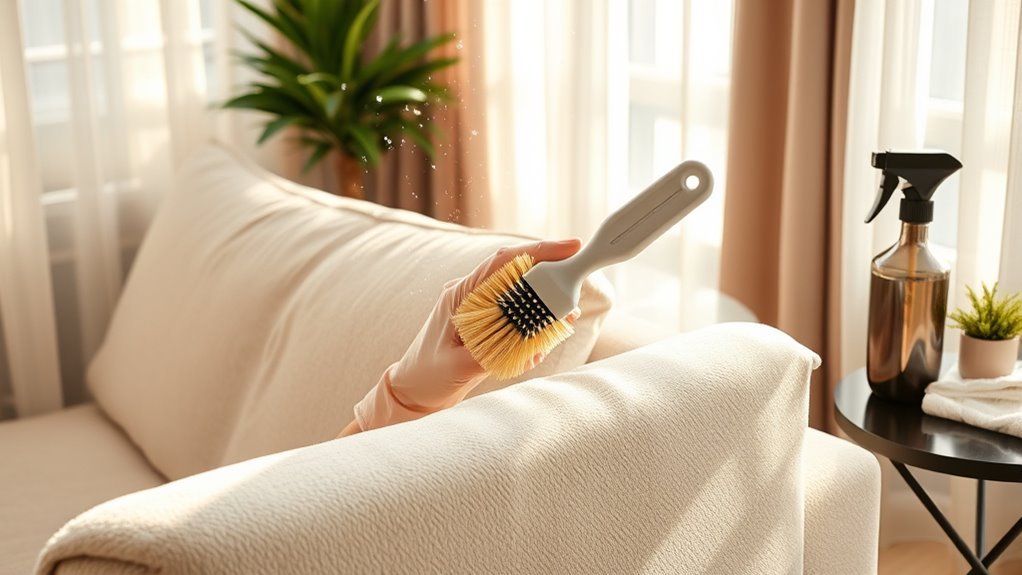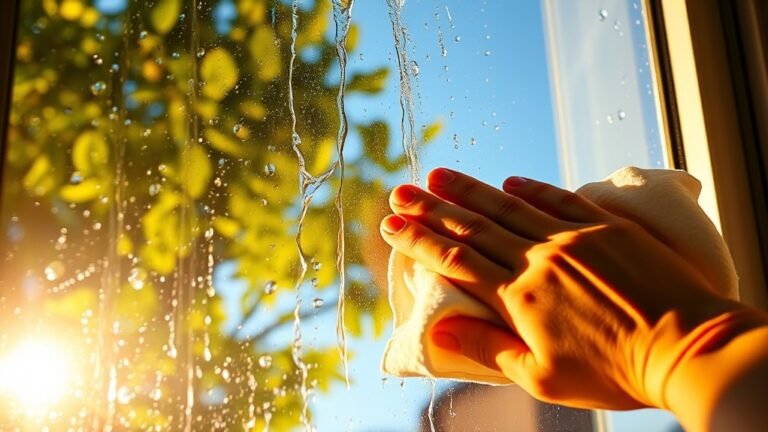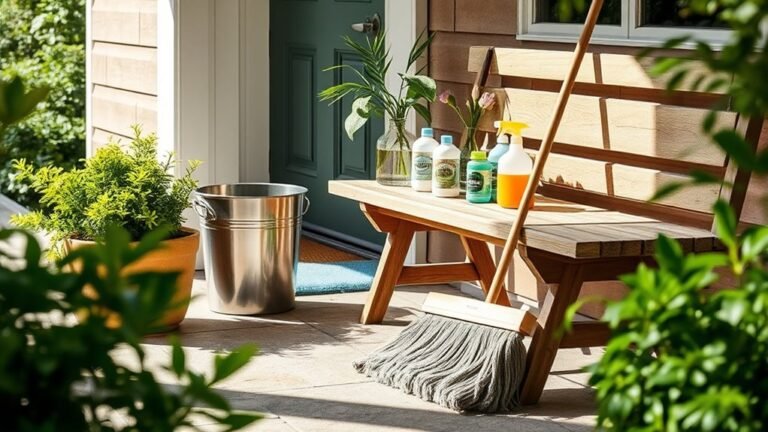How to Clean Sofa
To clean your sofa effectively, first identify its material by checking tags or texture. Gather supplies like a vacuum with upholstery attachments, mild detergent, and microfiber cloths. Vacuum every corner carefully, focusing on seams. Treat stains cautiously based on type—water-based, oil, or protein—testing cleaners on hidden spots. For leather, use mild soap and conditioner sparingly. Deep clean with steam if safe, then dry thoroughly in a ventilated area. Follow routine care to keep your sofa fresh and look at detailed methods for a flawless finish.
Identifying Your Sofa Material

How do you determine what material your sofa is made of? Start by examining the sofa types commonly available: leather, synthetic fibers, natural fibers, or blends. Check the manufacturer’s tag, usually located under the cushions or frame, for exact fiber content. If the tag’s missing, observe the fabric characteristics—leather feels smooth and cool, while synthetic fabrics like polyester or microfiber are soft and resistant to wrinkles. Natural fibers such as cotton or linen tend to have a matte finish and absorb moisture quickly. Feel the texture and note the weave pattern; tighter weaves often indicate durability. Identifying your sofa material accurately allows you to choose cleaning methods that protect your furniture’s integrity while maximizing your freedom from damage or unnecessary wear.
Preparing Your Cleaning Supplies
Before you begin cleaning, gathering the right supplies is essential to guarantee effective and safe results. Start by creating a preparation checklist tailored to your sofa’s material. Essential cleaning supplies include a vacuum with upholstery attachments, mild detergent or fabric-specific cleaner, microfiber cloths, a soft brush, and a spray bottle with water. Avoid harsh chemicals unless your sofa’s fabric can tolerate them. Also, have gloves handy to protect your hands and test any cleaner on a hidden spot first. Ensuring you have everything at arm’s reach streamlines the process and prevents interruptions. With your preparation checklist complete, you set a foundation for thorough, efficient cleaning. This methodical approach gives you control and freedom over maintaining your sofa’s appearance without guesswork or wasted effort.
Vacuuming Your Sofa Thoroughly

With your cleaning supplies ready, the next step is vacuuming your sofa thoroughly to remove dust, dirt, and debris that settle deep within the fabric and crevices. Follow these steps to guarantee a thorough clean:
Prepare your cleaning supplies and vacuum your sofa thoroughly to remove hidden dust, dirt, and debris from every crevice.
- Select the appropriate vacuum settings based on your sofa’s fabric to avoid damage while maximizing suction.
- Attach sofa attachments such as a brush or crevice tool to reach tight spaces and delicate areas.
- Vacuum systematically, starting from the top cushions, moving to armrests, and finally the base to guarantee no area is missed.
- Pay special attention to seams and folds where dirt tends to accumulate.
Treating Common Sofa Stains
When treating common sofa stains, you first need to identify the type of stain to choose the right cleaning method. Different stains like food, ink, or grease require specific techniques and products for effective removal. By understanding these distinctions, you’ll guarantee your sofa gets the proper care without causing damage.
Identifying Stain Types
How can you effectively treat stains on your sofa without knowing what caused them? Accurate stain identification is essential before applying any cleaning solutions. Different stains require specific treatments to avoid damage or spreading.
Here’s a quick guide to common stain types:
- Oil-based stains: Grease, makeup, or food oils; require solvents or degreasers.
- Water-based stains: Coffee, juice, or pet accidents; typically respond well to mild detergents.
- Protein stains: Blood, sweat, or dairy; need enzymatic cleaners for breakdown.
- Tannin stains: Wine or tea; acidic cleaners like vinegar solutions work best.
Effective Cleaning Techniques
A targeted cleaning approach is crucial for treating common sofa stains effectively. Start by identifying the stain type, then apply an appropriate eco friendly solution. For water-based stains like coffee or juice, use a mixture of white vinegar and water as a DIY cleaner. Blot gently—never rub—to avoid spreading. For oil-based stains, sprinkle baking soda to absorb grease before vacuuming. Then, use mild dish soap diluted in water to lift residue. Always test your cleaner on a hidden area first. After treating, let the fabric air dry completely to prevent mildew. By relying on carefully selected eco friendly solutions and DIY cleaners, you maintain your sofa’s integrity while embracing freedom from harsh chemicals. This methodical routine guarantees your sofa stays fresh and inviting.
Using Fabric Cleaner on Upholstery

You’ll want to select a fabric cleaner that matches your sofa’s material to avoid damage. Apply the cleaner carefully, testing it on a hidden area first to guarantee it won’t discolor or weaken the fabric. Use gentle, circular motions and avoid soaking the upholstery to achieve the best results.
Choosing the Right Cleaner
When selecting a cleaner for your upholstery, which factors should you consider to avoid damage? Choosing the right cleaner is essential to maintain your sofa’s integrity and appearance. Here’s what to keep in mind:
- Fabric type: Check the manufacturer’s label to identify suitable cleaners.
- Cleaner composition: Decide between natural cleaners, which are gentle and eco-friendly, and commercial cleaners, which may offer stronger stain removal but could be harsher.
- pH level: Opt for a cleaner with a neutral pH to prevent fabric discoloration or degradation.
- Test area: Always test the cleaner on a hidden spot to verify it doesn’t cause fading or damage.
Application Techniques
Selecting the right cleaner sets the foundation, but how you apply it determines the effectiveness and safety of the cleaning process. When using fabric cleaner on upholstery, you can choose between sponge application or the spray method. For sponge application, dampen a clean sponge lightly with the cleaner and gently dab the fabric, focusing on stains without oversaturating. This controlled approach helps you avoid water damage. Alternatively, the spray method allows even distribution; hold the bottle about 6-8 inches from the surface and mist the fabric lightly. Always test in an inconspicuous area first to verify colorfastness. After applying cleaner, use a soft brush or cloth to agitate gently, then blot excess moisture. Proper technique guarantees a thorough clean while preserving your sofa’s fabric integrity, giving you freedom from worries.
Cleaning Leather Sofas Safely
Although leather sofas are durable, cleaning them requires careful attention to avoid damage. To preserve your sofa’s look and feel, stick to safe cleaning methods and understand leather conditioner benefits. Here’s how you can clean leather safely:
- Vacuum gently with a soft brush to remove debris without scratching.
- Use a damp cloth with mild soap; avoid harsh chemicals that strip oils.
- Apply a leather conditioner sparingly to maintain moisture and flexibility.
- Test any cleaner on a hidden spot first to guarantee no discoloration occurs.
Following these steps gives you freedom from worry, keeping your leather sofa supple and clean while extending its lifespan. Safe cleaning preserves both beauty and comfort.
Removing Odors From Your Sofa
Why does your sofa sometimes hold onto unpleasant smells even after cleaning? Odors often embed deep within upholstery fibers, where surface cleaning can’t reach. To effectively remove these smells, start by vacuuming thoroughly to eliminate dust and debris. Next, apply a quality odor neutralizer designed for fabrics; these products chemically bind with odor molecules, neutralizing rather than masking them. Avoid using overpowering fabric fresheners initially, as they might only cover the problem temporarily. Instead, opt for fresheners that complement odor neutralizers to maintain a clean scent without overwhelming your space. Confirm the sofa dries completely after treatment to prevent mold or mildew, which can worsen odors. Taking these precise steps lets you reclaim a fresh, inviting sofa that supports your freedom to enjoy your living space.
Deep Cleaning With Steam
When you want to remove deep-seated dirt and allergens from your sofa, steam cleaning is an effective method that penetrates beyond surface fibers. To harness steam cleaning benefits while protecting your sofa, follow these steps carefully:
- Check your sofa’s fabric care label to verify it can handle steam cleaning.
- Vacuum thoroughly to remove loose debris before steaming.
- Use a steam cleaner designed for upholstery, maintaining the recommended distance to avoid fabric damage.
- Perform a spot test in an inconspicuous area to observe any adverse effects.
Drying and Maintaining Your Sofa
After cleaning, you’ll need to dry your sofa thoroughly to prevent mold and odors, using fans or natural airflow. Consistent maintenance, like regular vacuuming and spot cleaning, will keep your sofa looking fresh and extend its lifespan. Let’s explore the best practices for drying and maintaining your sofa effectively.
Proper Sofa Drying
Although it might be tempting to speed up the drying process, proper sofa drying requires patience and controlled conditions to prevent damage. Managing sofa moisture correctly guarantees your furniture remains fresh and intact. Follow these essential drying techniques:
- Position your sofa in a well-ventilated room, avoiding direct sunlight that can fade fabric.
- Use fans to circulate air gently but avoid high heat which may warp or shrink materials.
- Remove cushions and let them dry separately to allow airflow to all areas.
- Check moisture levels regularly by touching or using a moisture meter to confirm thorough drying.
Routine Sofa Maintenance
Proper drying sets the foundation for effective sofa maintenance, but keeping your sofa in top condition requires consistent care beyond just moisture management. To guarantee lasting sofa upkeep, perform routine inspections weekly. Check for signs of wear, loose threads, or stains that may need immediate attention. Vacuum your sofa regularly to remove dust and debris that can deteriorate fabric fibers. Rotate cushions to promote even wear and maintain shape. Avoid direct sunlight to prevent fading, and keep pets off to reduce damage. If you spot minor issues during inspections, address them promptly to avoid costly repairs later. By integrating these methodical steps into your routine, you’ll preserve your sofa’s appearance and comfort, granting you the freedom to enjoy your living space without worry.
Tips for Preventing Future Stains
While preventing stains may seem challenging, adopting a few strategic habits can markedly protect your sofa’s fabric. Using stain repellents and fabric protectors is a smart first step—they create a barrier that resists spills and dirt. To maintain this protection and keep your sofa looking fresh, follow these tips:
Prevent stains by using fabric protectors that resist spills and dirt, keeping your sofa fresh and clean.
- Apply fabric protectors periodically according to manufacturer instructions.
- Establish a no-food-or-drink rule to minimize accidental spills.
- Regularly vacuum your sofa to prevent dust and debris buildup.
- Use removable covers or throws in high-traffic areas for added defense.
Frequently Asked Questions
How Often Should I Clean My Sofa Professionally?
Think of your sofa as a well-tended garden; scheduling cleanings is like pruning to keep it vibrant and healthy. Professional recommendations usually suggest a deep clean every 12 to 18 months, depending on use and pets. By sticking to this methodical schedule, you’ll preserve your freedom from stubborn stains and allergens, letting your space breathe easy. Trusting experts guarantees your sofa stays fresh, inviting, and ready for life’s moments.
Can Sofa Cleaning Improve Indoor Air Quality?
Absolutely, cleaning your sofa can improve indoor air quality by removing indoor allergens like dust mites, pet dander, and mold trapped in sofa materials. Different fabrics hold allergens differently, so understanding your sofa’s material helps you choose the right cleaning method. Regularly maintaining your sofa guarantees you breathe cleaner air, giving you more freedom to enjoy your space comfortably and healthily. It’s a simple step that makes a big difference.
What Are Eco-Friendly Alternatives to Commercial Cleaners?
Imagine your cleaning routine as a gentle breeze that refreshes without harshness. You can ditch commercial cleaners by mixing a vinegar solution—equal parts vinegar and water—for a natural disinfectant. Sprinkle baking soda over surfaces to absorb odors like a soft, silent guardian. These eco-friendly alternatives let you reclaim freedom from chemicals, offering a methodical yet simple way to cleanse your space with care and confidence.
How Do I Repair Tears or Rips in Sofa Fabric?
When you spot tears in your sofa fabric, start by trimming any loose threads. Cut a fabric patch slightly larger than the rip from a matching material. Apply upholstery adhesive to the patch’s edges and press it firmly beneath the tear, ensuring a smooth surface. Hold it in place until the adhesive sets. This method restores your sofa’s look without sewing, giving you freedom to fix damage quickly and effectively.
Are Slipcovers a Good Option for Sofa Protection?
Imagine your sofa as a knight’s armor, guarding against daily battles like spills and pet claws. Slipcovers act as a versatile shield, offering slipcover benefits like easy cleaning and style changes. You’ll find fabric types ranging from cotton to waterproof polyester, each providing unique protection and comfort. They’re practical for preserving your sofa’s life while giving you freedom to refresh your space without commitment. Slipcovers truly blend defense with design.






